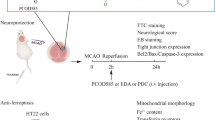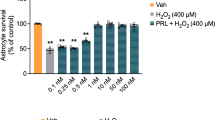Abstract
Purpose
Edaravone, a free radical scavenger, has shown neuroprotection in both animals and humans. To evaluate the mechanism of this protection, we examined the effect of edaravone on neurons themselves against glutamate neurotoxicity.
Methods
Neurons were collected from 18-day fetal rat brains and a culture of almost pure neurons was obtained after 14-day culture. The neurons were exposed to 50 μM glutamate for 10 min, followed by normal culture for 24 h. Edaravone was added to the medium during the glutamate insult (prophylactic effect) or after the insult (treatment effect). First, the cell survival rate was measured by staining with trypan blue. Second, the cells were stained with 6-carboxy-2′, 7′-dichlorodihydrofluorescein diacetate, di-(acetoxymethyl ester) (C-DCDHF-DA) and the relative amount of reactive oxygen species (ROS) was measured by flow cytometry. Third, the cells were stained with Hoechst 33342 and propidium iodide and the numbers of apoptotic and necrotic cells were counted.
Results
A dose-dependent prophylactic effect was observed and the cell survival rate in 500 μM edaravone was significantly higher than that without it. However, there was no treatment effect beyond 2 h after the insult. The amount of ROS under 500 μM edaravone at 4 h after the glutamate insult was significantly lower than the control amount. Necrosis, but not apoptosis, was significantly inhibited by edaravone.
Conclusion
Edaravone mainly showed a prophylactic effect on neurons against glutamate neurotoxicity, possibly through the inhibition of necrosis via the suppression of ROS production. However, for a protective effect, a higher, supraclinical concentration was required, compared to the concentrations producing a protective effect in glial and endothelial cells in previous studies.
Similar content being viewed by others
References
Kawaguchi M, Furuya H, Patel PM. Neuroprotective effects of anesthetic agents. J Anesth. 2005;19:150–156.
Grocott HP, Yoshitani K. Neuroprotection during cardiac surgery. J Anesth. 2007;21:367–377.
Yamamoto T, Yuki S, Watanabe T, Mitsuka M, Saito KI, Kogure K. Delayed neuronal death prevented by inhibition of increased hydroxyl radical formation in a transient cerebral ischemia. Brain Res. 1997;762:240–242.
Kawai H, Nakai H, Suga M, Yuki S, Watanabe T, Saito KI. Effects of a novel free radical scavenger, MCl-186, on ischemic brain damage in the rat distal middle cerebral artery occlusion model. J Pharmacol Exp Ther. 1997;281:921–927.
Shichinohe H, Kuroda S, Yasuda H, Ishikawa T, Iwai M, Horiuchi M, Iwasaki Y. Neuroprotective effects of the free radical scavenger edaravone (MCI-186) in mice permanent focal brain ischemia. Brain Res. 2004;1029:200–206.
Edaravone Acute Infarction Study G. Effect of a novel free radical scavenger, edaravone (MCI-186), on acute brain infarction. Randomized, placebo-controlled, double-blind study at multicenters. Cerebrovasc Dis. 2003;15:222–229.
Toyoda K, Fujii K, Kamouchi M, Nakane H, Arihiro S, Okada Y, Ibayashi S, Iida M. Free radical scavenger, edaravone, in stroke with internal carotid artery occlusion. J Neurol Sci. 2004;221:11–17.
Mishina M, Komaba Y, Kobayashi S, Tanaka N, Kominami S, Fukuchi T, Mizunari T, Hamamoto M, Teramoto A, Katayama Y. Efficacy of edaravone, a free radical scavenger, for the treatment of acute lacunar infarction. Neurol Med Chir (Tokyo). 2005;45:344–348.
Ogasawara K, Yamadate K, Kobayashi M, Endo H, Fukuda T, Yoshida K, Terasaki K, Inoue T, Ogawa A. Effects of the free radical scavenger, edaravone, on the development of postoperative cognitive impairment in patients undergoing carotid endarterectomy. Surg Neurol. 2005;64:309–313.
Zhang N, Komine-Kobayashi M, Tanaka R, Liu M, Mizuno Y, Urabe T. Edaravone reduces early accumulation of oxidative products and sequential inflammatory responses after transient focal ischemia in mice brain. Stroke. 2005;36:2220–2225.
Banno M, Mizuno T, Kato H, Zhang G, Kawanokuchi J, Wang J, Kuno R, Jin S, Takeuchi H, Suzumura A. The radical scavenger edaravone prevents oxidative neurotoxicity induced by peroxynitrite and activated microglia. Neuropharmacology. 2005;48: 283–290.
Itoh Y, Takaoka R, Ohira M, Abe T, Tanahashi N, Suzuki N. Reactive oxygen species generated by mitochondrial injury in human brain microvessel endothelial cells. Clin Hemorheol Microcirc. 2006;34:163–168.
Nito C, Kamiya T, Amemiya S, Katoh K, Katayama Y. The neuroprotective effect of a free radical scavenger and mild hypothermia following transient focal ischemia in rats. Acta Neurochir (Wien). 2003;86:199–203.
Wu T, Ding XS, Wang W, Wu J. MCI-186 (3-methyl-1-phenyl-2-pyrazolin-5-one) attenuated simulated ischemia/reperfusion injury in cultured rat hippocampal cells. Biol Pharm Bull. 2006;29:1613–1617.
Song Y, Li M, Li JC, Wei EQ. Edaravone protects PC12 cells from ischemic-like injury via attenuating the damage to mitochondria. J Zhejiang Univ Sci B. 2006;7:749–756.
Xie C, Markesbery WR, Lovell MA. Survival of hippocampal and cortical neurons in a mixture of MEM+ and B27-supplemented neurobasal medium. Free Radic Biol Med. 2000;28:665–672.
Miura E, Fukaya M, Sato T, Sugihara K, Asano M, Yoshioka K, Watanabe M. Expression and distribution of JNK/SAPK-associated scaffold protein JSAP1 in developing and adult mouse brain. J Neurochem. 2006;97:1431–1446.
Nakamura M, Sato K, Fukaya M, Araishi K, Aiba A, Kano M, Watanabe M. Signaling complex formation of phospholipase Cbeta4 with metabotropic glutamate receptor type 1alpha and 1,4,5-trisphosphate receptor at the perisynapse and endoplasmic reticulum in the mouse brain. Eur J Neurosci. 2004;20:2929–2944.
Yamasaki M, Yamada K, Furuya S, Mitoma J, Hirabayashi Y, Watanabe M. 3-Phosphoglycerate dehydrogenase, a key enzyme for l-serine biosynthesis, is preferentially expressed in the radial glia/astrocyte lineage and olfactory ensheathing glia in the mouse brain. J Neurosci. 2001;21:7691–7704.
Shibuta S, Kosaka J, Inoue T, Shimizu T, Tomi K, Mashimo T. The influence of the timing of administration of thiopentone sodium on nitric oxide-mediated neurotoxicity in vitro. J Neurol Sci. 2000;174:9–15.
Shibuta S, Varathan S, Mashimo T. The neuroprotective effect of ONO-1714 on NMDA-mediated cytotoxicity in vitro. J Neurol Sci. 2003;215:31–36.
Aoshima H, Satoh T, Sakai N, Yamada M, Enokido Y, Ikeuchi T, Hatanaka H. Generation of free radicals during lipid hydroperoxide-triggered apoptosis in PC12h cells. Biochim Biophys Acta. 1997;1345:35–42.
Satoh T, Numakawa T, Abiru Y, Yamagata T, Ishikawa Y, Enokido Y, Hatanaka H. Production of reactive oxygen species and release of L-glutamate during superoxide anion-induced cell death of cerebellar granule neurons. J Neurochem. 1998;70:316–324.
Shimizu S, Eguchi Y, Kamiike W, Itoh Y, Hasegawa J, Yamabe K, Otsuki Y, Matsuda H, Tsujimoto Y. Induction of apoptosis as well as necrosis by hypoxia and predominant prevention of apoptosis by Bcl-2 and Bcl-XL. Cancer Res. 1996;56: 2161–2166.
Choi DW, Rothman SM. The role of glutamate neurotoxicity in hypoxic-ischemic neuronal death. Annu Rev Neurosci. 1990;13: 171–1782.
Choi DW, Maulucci-Gedde M, Kriegstein AR. Glutamate neurotoxicity in cortical cell culture. J Neurosci. 1987;7:357–368.
Atlante A, Calissano P, Bobba A, Azzariti A, Marra E, Passarella S. Cytochrome c is released from mitochondria in a reactive oxygen species (ROS)-dependent fashion and can operate as a ROS scavenger and as a respiratory substrate in cerebellar neurons undergoing excitotoxic death. J Biol Chem. 2000;275:37 159–371 66.
Chi CW, Wang CN, Lin YL, Chen CF, Shiao YJ. Tournefolic acid B methyl ester attenuates glutamate-induced toxicity by blockade of ROS accumulation and abrogating the activation of caspases and JNK in rat cortical neurons. J Neurochem. 2005;92:692–700.
Watanabe T, Yuki T, Saito K, Sato S, Sugimoto J, Ohori Y. Pharmacological studies of MCI-186, a new drug for acute stroke (in Japanese with English abstract). Jpn Pharmacol Ther. 1997;25: S1691–s1697.
Chihab R, Bossenmeyer C, Oillet J, Daval JL. Lack of correlation between the effects of transient exposure to glutamate and those of hypoxia/reoxygenation in immature neurons in vitro. J Neurochem. 1998;71:1177–1186.
Nicholls DG. Mitochondrial dysfunction and glutamate excitotoxicity studied in primary neuronal cultures. Curr Mol Med. 2004;4:149–177.
Yasuoka N, Nakajima W, Ishida A, Takada G. Neuroprotection of edaravone on hypoxic-ischemic brain injury in neonatal rats. Dev Brain Res. 2004;151:129–139.
Tanaka S, Takehashi M, Iida S, Kitajima T, Kamanaka Y, Stedeford T, Banasik M, Ueda K. Mitochondrial impairment induced by poly(ADP-ribose) polymerase-1 activation in cortical neurons after oxygen and glucose deprivation. J Neurochem. 2005;95: 179–190.
Gong QH, Wang Q, Shi JS, Huang XN, Liu Q, Ma H. Inhibition of caspases and intracellular free Ca2+ concentrations are involved in resveratrol protection against apoptosis in rat primary neuron cultures. Acta Pharmacol Sin. 2007;28:1724–1730.
Baba N, Miura M. The single dose toxicity study of MCI-186 (in Japanese with English abstract). Jpn Pharmacol Ther. 1997;25: 1517–1530.
Author information
Authors and Affiliations
About this article
Cite this article
Hisano, K., Watanabe, M. & Morimoto, Y. Protective effects of the free radical scavenger edaravone against glutamate neurotoxicity in nearly pure neuronal culture. J Anesth 23, 363–369 (2009). https://doi.org/10.1007/s00540-009-0766-z
Received:
Accepted:
Published:
Issue Date:
DOI: https://doi.org/10.1007/s00540-009-0766-z




